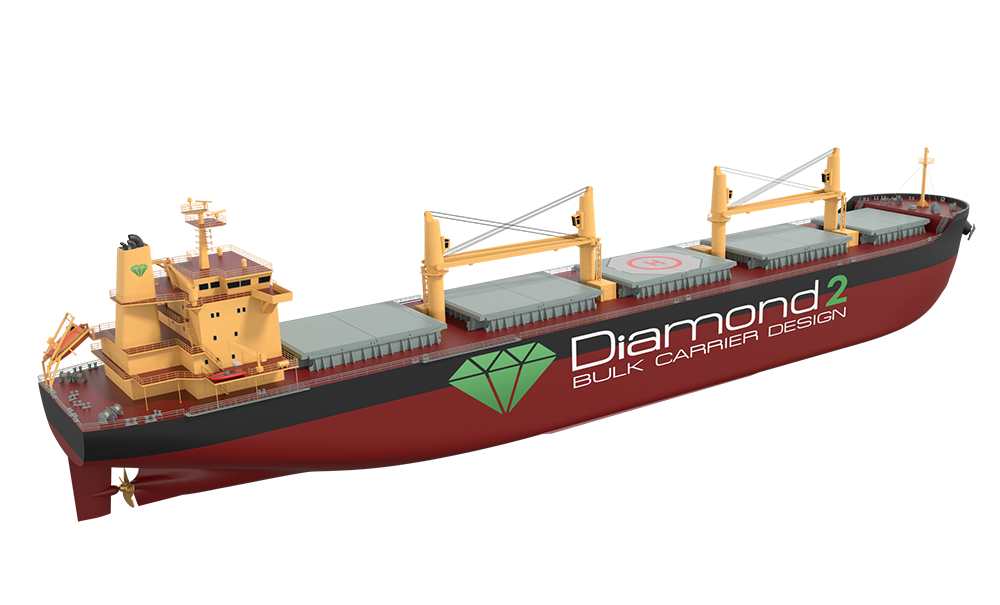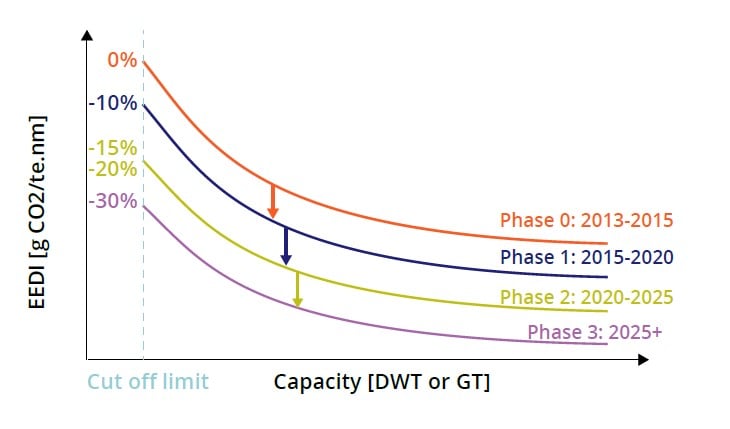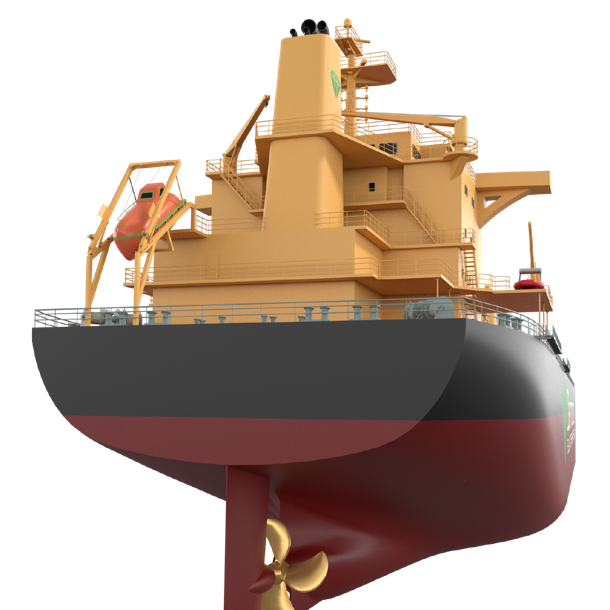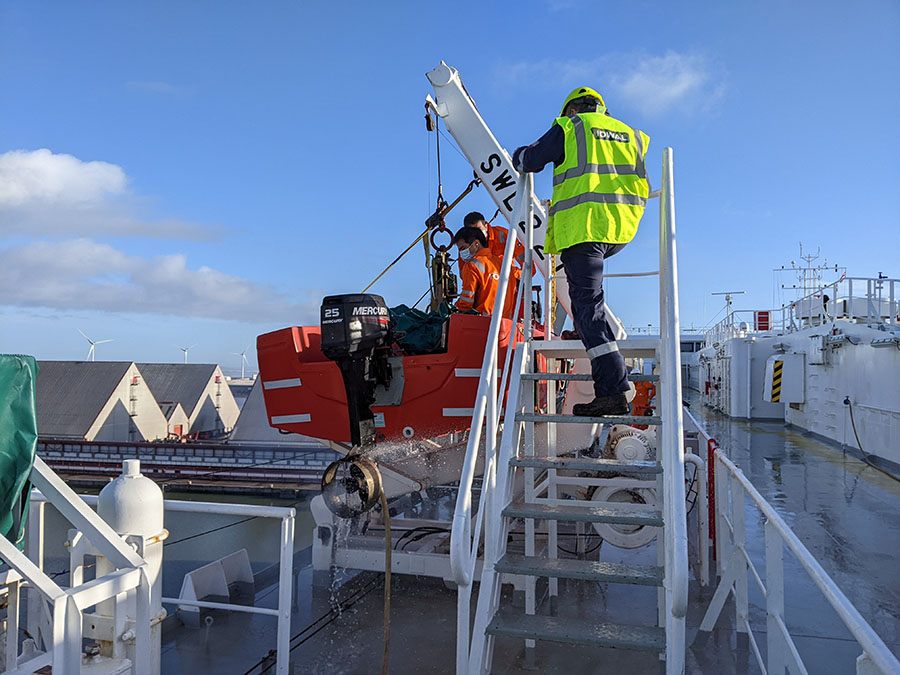
Diamond 2 is a new generation of Ultramax type Bulk Carrier, embracing the latest sustainable thinking and in particular, focused to meet the needs of IMO 2030.
Further to IMO 2030, the Diamond 2 design with its high fuel efficiency and optimisation to trade within normal Ultramax operational speeds, is very well positioned to meet the challenges of the carbon reduction ambitions from IMO, Financial Institutions, Cargo Owners and with the introduction of EEXI and the Carbon Intensity Rating Scheme. The design has been further developed to provide a series of investment options for emission abatement and for compliance to trade for full vessel life.
Following the successful original Diamond 53 Bulk Carrier, Diamond 2 is designed in close cooperation with cargo and ship owners to create the class-leading, future-orientated Bulk Carrier.





Feedback from vessels in service will be assessed by designers and fed back to the shipyard to evolve and improve the design. Extensive tank testing in Germany, including the world renowned HSVA in Hamburg has given designers full confidence in the fuel consumption as stated below. It is understood that SVA in Potsdam remarked that it is the best hull tested by far.
Diamond 2 has a low EEDI (Energy Efficiency Design Index) that can fulfil the Phase 3 requirement, which is 30% below the IMO reference line for bulk carriers and not due to enter into force until 2025. It can be further reduced
to meet IMO goals in 2030 by reducing the operational speed to just under 13knts. Data has been analysed by DNVGL in line with the Poseidon principles to determine the Diamond 2 compliance trajectory, thus fully revealing future environmental compliance.
In order to achieve reduced fuel consumption and emissions, the hull has been optimized following work carried out by DNVGL for a well-defined realistic operating profile using the most advanced optimization methodologies, tools and competence available in the market. The operating profile covers ballast/design/scantling draughts and the most common service speeds as evidenced by study of AIS data. weather as well as calmer conditions.
With the vessel optimized, for real world operational parameters at around 12knts, the vessel is very well placed to take advantage of significant savings when operating at lower speeds. At 10knts the vessel will consume circa 9t per day in the main engine. It is features such as those highlighted, that clearly differentiate the significant gulf between investment in a modern,
efficient and fully compliant future-proof newbuilding like Diamond 2 and the second-hand market. Compliance with Phase 3 EEDI places Diamond 2 in only 1% of similar vessels. Calculations from IMO published EEDI data on
Bulk Carriers between 57k and 68k (715 vessels delivered between 2012 to 2019) show 0.7% phase 0, 26.3% Phase 1 and 72% Phase 2.
To further improve propulsion and hydrodynamic performance, the design features a high-efficiency propeller and a rudder with a vortex-reducing bulb,
this offers a high propulsion efficiency and avoids the potential for cavitation. Consequently, noise pollution is greatly reduced to the benefit of sensitive marine species such as Whales and Dolphins. Furthermore, a vertical bow
design is adopted for improved performance in adverse conditions.
Diamond 2 is fitted with the latest version of a proven and reliable, ultra-long stroke main engine, achieving very low overall fuel consumption. Main and Auxiliary engines comply with NOx Tier II requirements; an option is available for compliance to Tier III. Cutting-edge software tools have been used to assess and optimize the complex integrated ship systems to ensure maximum machinery and electrical system efficiency to reduce the fuel consumed in generators by around 8% generally. The same tools can be used in service to ensure optimal performance with sophisticated data management.
Low maintenance LED lighting together with frequency controlled SW cooling pumps and engine room fans reduces generator loads. Waste heat recovery from two auxiliary engines supplements the exhaust gas economizer, particularly important at lower operational speeds to avoid consuming fuel in the oil-fired boiler. All in all, these measures ensure that Diamond 2 achieves low fuel consumption and emissions both at sea and in port.
Diamond 2 has space available for the retrofit of a scrubber and its associated equipment, depending upon owner’s fuel and emission compliance strategy. Meanwhile, in case a scrubber is not fitted at newbuilding stage, low Sulphur fuel grades are used for compliance.
An IMO approved and USCG certificated, energy efficient, ballast water treatment plant is installed on board to reduce the global transfer of potentially harmful aquatic organisms and pathogens.
Equipped for the digital age, a shaft torque meter, sensors and fuel mass type flow meters are installed, facilitating advanced performance monitoring and follow up by managers utilizing a ship performance system.
Not least, Diamond 2 has the voluntary class notations Clean, Recycling and even Shaft Align for enhanced shaft alignment/bearing reliability.
The vessel accommodation arrangement complies with the latest MLC2006 requirements. It is further designed to achieve low levels of noise and vibration for the crew and lessen the environmental impact on aquatic life.
High speed broadband is available on board allowing crew members close contact with loved ones and friends.
The structural design is in accordance with the latest harmonised common structural rules for bulk carriers. The steering gear room is designed and arranged as a Citadel to protect the crew against an act of piracy. Hatch covers are of double-skin hydraulic folding type and feature double sealing at cross joints to further reduce the risk of water ingress.
The ship is laid out with five (5) cargo holds intended for the carriage of a wide range of major and minor bulk cargoes, special consideration is embedded in both design and specification to facilitate efficient hold cleaning. The tank top is designed for heavy cargoes. Four Cargo Cranes
each of 35t capacity, service any need for the vessel to work without shore based offloading facilities. Focusing on high energy efficiency, the deadweight capacity is maximized through design and weight optimization of the structural arrangement and tank layout, combined with various loading case analyses. Mooring arrangements satisfy the requirements for transiting the new locks of the Panama Canal.


Length OA: 199.99m
Length BP: 196.75m
Breadth, MLD: 32.26m
Depth, MLD: 18.50m
Design / scantling draft: 11.30/13.30m
Cargo holds (grain): 77,400m3
Heavy fuel oil tanks: 1,700m3
Heavy fuel oil or diesel oil (dual purpose): 340m3
Diesel oil tanks: 200m3
Fresh water tanks: 360m3
Distillate water tanks: 40m3
Water ballast tanks: 18,300m3
Deadweight at scantling draft: 63,300mt
DNVGL X 1A Bulk Carrier, ESP, CSR, BC(A) Holds 2, 4 may be empty, GRAB(20), COAT-PSPC (B), CMON, BIS, LCS, E0, CLEAN, BWM(T), Shaft Align, TMON(Oil Lubricated), DG(B), Recyclable.
The below figures have been verified through tank tests at leading facilities in Germany, including HSVA.
Service speed at scantling draft: 13.50 knots
M/E fuel consumption: 22.3 t/d
Service speed at design draft: 14.00 knots
M/E fuel consumption: 21.4 t/d
Eco speed at scantling draft: 12.00 knots
M/E fuel consumption: 15.4 t/d
All including a 15% sea margin but exclusive of potential savings of a further 3-5%* with ESD at Buyers extra cost option.
*Device manufacturers estimates (Will be required to meet Phase 3 EEDI)
Generator consumption around 2.2t/d depending upon load.
(ISO ambient conditions, LCV=42,700kJ/kg), excluding manufacturers tolerances.
20,000 nautical miles.
Phase 3
Hatch Covers Hydraulically operated folding type. Double seals on cross joint.
Deck Cranes Four (4) electro-hydraulic single deck cranes, each with a capacity of 35t S.W.L. x 29m.
Main Engine
Emergency Diesel Generator
Steam Generating Plant
Ballast Pump
Note: The final technical data and performance parameters mentioned above please refer to the formal contract documents.
Cabins for 25P + 6P (Suez), fully air-conditioned.

Your partner for structuring shipping investments.
Graig Shipping PLC is registered in England and Wales No: 157048
5th Floor, 1 Capital Quarter, Tyndall Street, Cardiff, United Kingdom, CF10 4BZ
